As the temperatures drop and the days grow shorter, the onset of the sick season is becoming increasingly evident across the United States. Recent data released by the Centers for Disease Control and Prevention (CDC) paints a concerning picture of rising illness rates, particularly with influenza and other respiratory infections. This annual phenomenon, characterized by a spike in various viral and bacterial infections, is a reminder of the importance of public health measures and individual vigilance during this time of year.
The CDC’s latest figures reveal that the incidence of flu-like symptoms has surged in recent weeks, with hospitalizations for influenza-related complications on the rise. This trend is not isolated to influenza; respiratory syncytial virus (RSV) and other respiratory infections are also contributing to the growing number of cases. The data indicates that healthcare systems are beginning to feel the strain, prompting health officials to issue warnings about the potential for a challenging season ahead.
One of the primary factors contributing to the sick season is the combination of seasonal changes and increased indoor gatherings. As people transition from outdoor activities to indoor settings, the close proximity can facilitate the spread of viruses. Furthermore, the waning immunity from previous infections and vaccinations may also play a role in the increased susceptibility to illness. Health experts emphasize the importance of vaccinations, particularly for influenza, as a critical tool in reducing the severity and spread of these diseases.
Vaccination campaigns are already underway, with health officials encouraging individuals, especially those in high-risk groups, to get their flu shots. The CDC recommends that everyone over the age of six months receive an annual influenza vaccine. This proactive measure is crucial not only for individual protection but also for community health, as higher vaccination rates can lead to herd immunity, thereby protecting those who are unable to receive vaccines due to medical reasons.
In addition to vaccinations, public health officials are advocating for other preventive measures. Simple practices such as frequent handwashing, wearing masks in crowded places, and maintaining good respiratory hygiene can significantly reduce the transmission of viruses. Health authorities are also urging individuals to stay home when feeling unwell to prevent spreading illness to others.
The CDC’s data also highlights the importance of surveillance and monitoring in understanding the dynamics of the sick season. Continuous tracking of illness patterns allows public health officials to identify outbreaks early and implement targeted interventions. This data-driven approach is essential in informing the public about the risks associated with seasonal illnesses and the necessary precautions to take.
As we move further into the sick season, it is vital for individuals to remain informed about the symptoms of common illnesses and to seek medical attention when necessary. Early diagnosis and treatment can be crucial in managing symptoms and preventing complications. Additionally, individuals are encouraged to pay attention to their health and that of their loved ones, particularly the elderly and those with underlying health conditions, who are at greater risk of severe illness.
The impact of the sick season extends beyond individual health; it also poses challenges for healthcare systems. Increased patient loads can strain resources, leading to longer wait times and potential disruptions in care for non-urgent medical needs. This situation underscores the importance of community preparedness and the need for individuals to take proactive steps to protect their health and that of others.
In conclusion, the latest CDC figures indicate that the sick season is indeed in full swing, with rising cases of influenza and respiratory infections. As we navigate this challenging time, it is essential to prioritize health and safety through vaccinations, preventive measures, and community awareness. By working together and taking the necessary precautions, we can help mitigate the impact of seasonal illnesses and protect our communities.



